In 2025, the explosion of digital content is making it harder than ever to keep assets organized, accessible, and secure. Without the right digital asset manager, businesses risk sinking into digital chaos as files multiply and teams struggle to collaborate efficiently.
A powerful digital asset manager tool can be the difference between a brand that thrives and one that falls behind. It helps you find, share, and leverage your assets with ease, turning clutter into clarity.
This article spotlights the 7 essential digital asset manager tools for 2025. We break down their features, pricing, benefits, and ideal use cases so you can confidently choose the best solution for your business.
What Is a Digital Asset Manager and Why It Matters in 2025
Managing digital content has become a complex challenge for organizations of all sizes. In 2025, the digital asset manager is no longer just a storage solution. It is an intelligent, central hub that transforms how teams access, organize, and use digital files. Let’s explore what a digital asset manager is, why it matters, and who can benefit most from these tools.
Defining Digital Asset Management
A digital asset manager is a software platform designed to store, organize, and distribute various digital files. Over the years, DAM systems have evolved far beyond simple file repositories. In 2025, they handle everything from images, videos, and documents to brand assets and creative files. As digital ecosystems grow more complex, keeping track of thousands of assets becomes a real challenge.
Modern digital asset manager tools leverage AI and automation to simplify asset discovery, automate tagging, and streamline workflows. This technology not only speeds up daily tasks but also ensures assets are always up to date. For marketing, sales, and creative teams, a digital asset manager enables quick access to approved materials, making collaboration seamless. For more insights into how AI is shaping DAM, check out this guide on AI-driven content intelligence in DAM.
Business Benefits of DAM Tools
Investing in a digital asset manager brings clear advantages to organizations. One major benefit is workflow efficiency. Teams spend less time searching for files and more time creating value. Centralized asset libraries help maintain brand consistency across all channels and campaigns.
A digital asset manager also improves collaboration, especially for remote or distributed teams. By storing assets in a single, secure location, businesses reduce the risk of file loss and cut redundant storage costs. Security features like permission controls and version tracking ensure compliance and protect sensitive data.
Key business benefits of a digital asset manager:
- Streamlined workflows and faster asset retrieval
- Consistent branding across platforms
- Enhanced team collaboration and sharing
- Centralized storage with strong security
- Reliable version control and audit trails
These benefits make the digital asset manager a cornerstone of modern content operations.
Who Needs a Digital Asset Manager Tool?
The demand for a digital asset manager is growing across industries. Enterprises with large marketing departments, creative agencies, and even solo creators all rely on DAM tools to stay organized. Industries like architecture, engineering, construction (AEC), e-commerce, media, and education are adopting DAM at record rates.
According to recent statistics, digital content creation is expected to grow exponentially in 2025. Remote work, content personalization, and data-driven marketing are fueling the need for efficient asset management. Whether you’re a global brand or a small business, a digital asset manager helps you keep pace with the rising volume and complexity of digital assets.
7 Essential Digital Asset Manager Tools for 2025
Choosing the right digital asset manager can make or break your content workflow in 2025. With the explosion of digital files, cloud-based DAM solutions are more critical than ever for businesses aiming to stay agile and organized. If you want to ensure your digital asset manager is future-proof, focus on solutions that combine AI, collaboration, and seamless integrations. Let’s dive into the seven tools leading the pack this year.
Bynder
Bynder is a powerhouse digital asset manager designed for enterprises seeking brand consistency and scalability. Its intuitive interface supports everything from creative workflow automation to advanced analytics, making it a favorite for global brands.
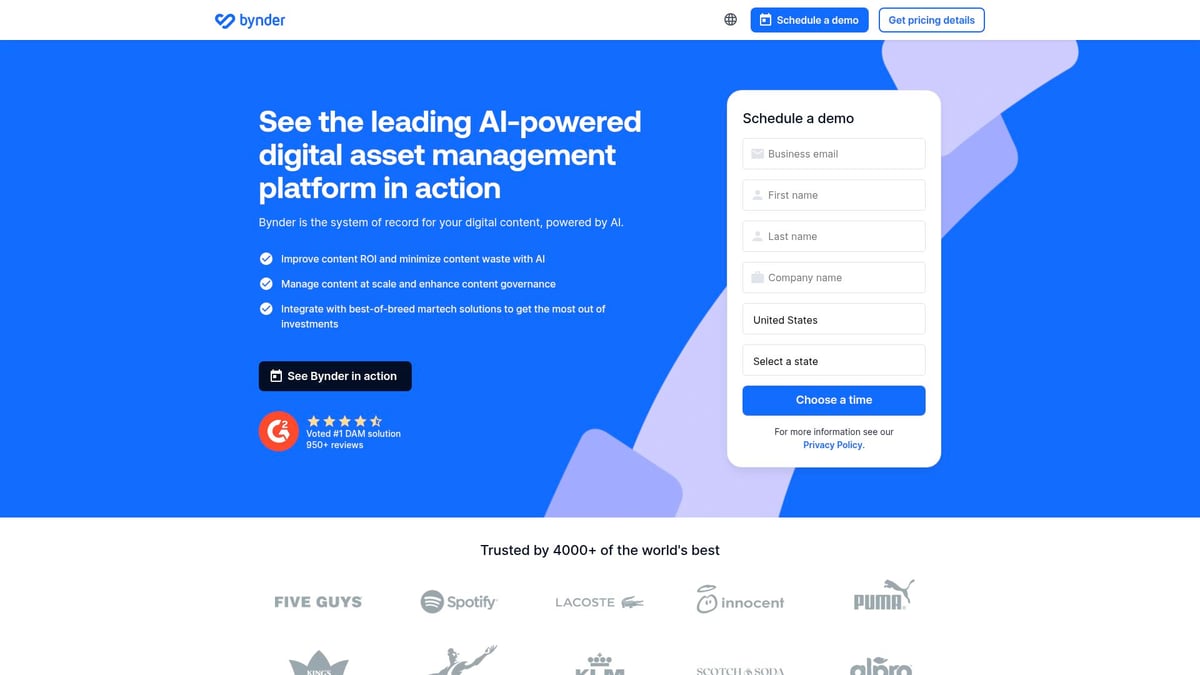
Pricing: Bynder offers custom quotes and a free demo, reflecting its tailored approach for each business.
Core Features:
- Brand portals for unified asset access
- AI-powered search for fast retrieval
- Creative workflow automation
- Version control for file accuracy
- In-depth analytics
Unique Selling Points:
- Enterprise-grade brand consistency
- Highly customizable integrations with Adobe, Office 365, CMS platforms
Ideal For: Large organizations, marketing teams, and global brands that need centralized control.
Pros:
- Scalable for complex needs
- Highly customizable
- Strong customer support
Cons:
- Higher cost than SMB options
- Potential complexity for small teams
Example: Spotify uses Bynder to manage its global brand assets efficiently.
If your digital asset manager must handle thousands of users and assets, Bynder delivers the structure and automation you need.
MediaValet
MediaValet is a cloud-native digital asset manager built for speed, collaboration, and security. With unlimited users and storage, it’s a favorite for creative agencies and enterprises managing massive digital libraries.
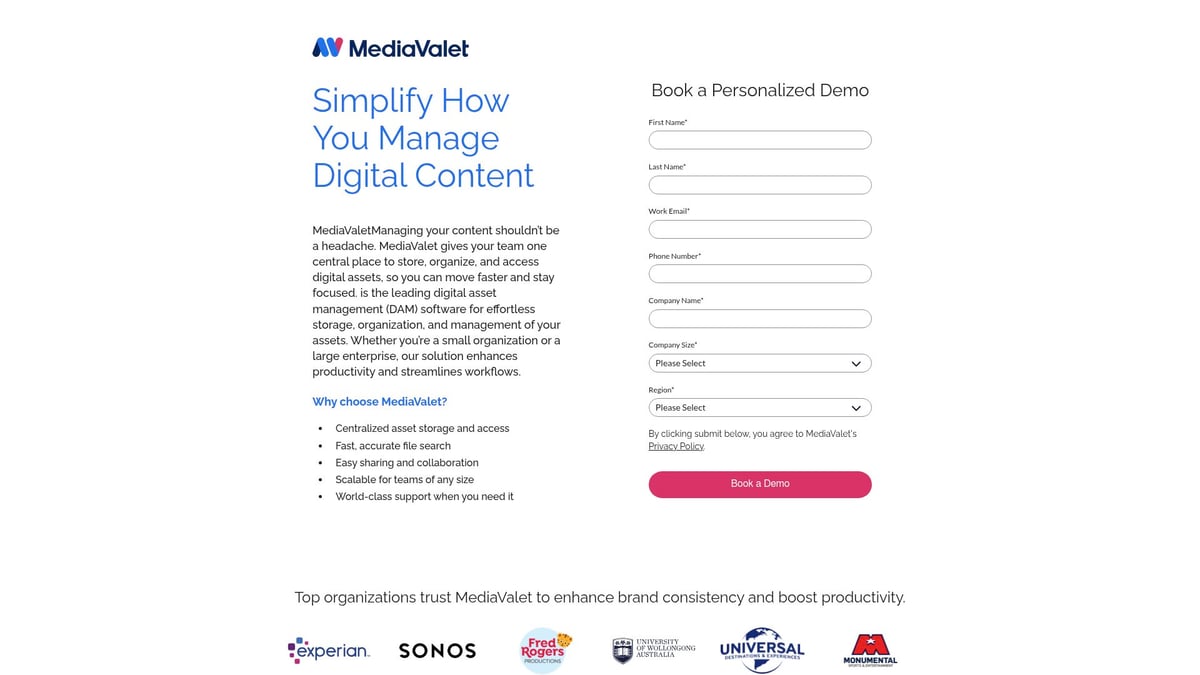
Pricing: Custom pricing with a free demo.
Features:
- AI-powered search and automated tagging
- Real-time team collaboration tools
- Strong security protocols
- Unlimited users and storage
Key Benefits:
- Lightning-fast asset retrieval
- Seamless collaboration for remote and large teams
- Enterprise-level data protection
Target Audience: Enterprises, creative agencies, media companies.
Pros:
- Unlimited scalability
- User-friendly interface
Cons:
- Premium pricing
- May offer more features than needed for SMBs
Example: MediaValet powers large-scale marketing campaigns for Fortune 500 companies, proving its value for high-volume digital asset manager needs.
If you want a digital asset manager that grows with your organization, MediaValet’s combination of ease and power is hard to beat.
Brandfolder
Brandfolder stands out as a digital asset manager focused on usability and actionable insights. Its AI-driven tools make asset organization and sharing effortless, even for teams collaborating across borders.
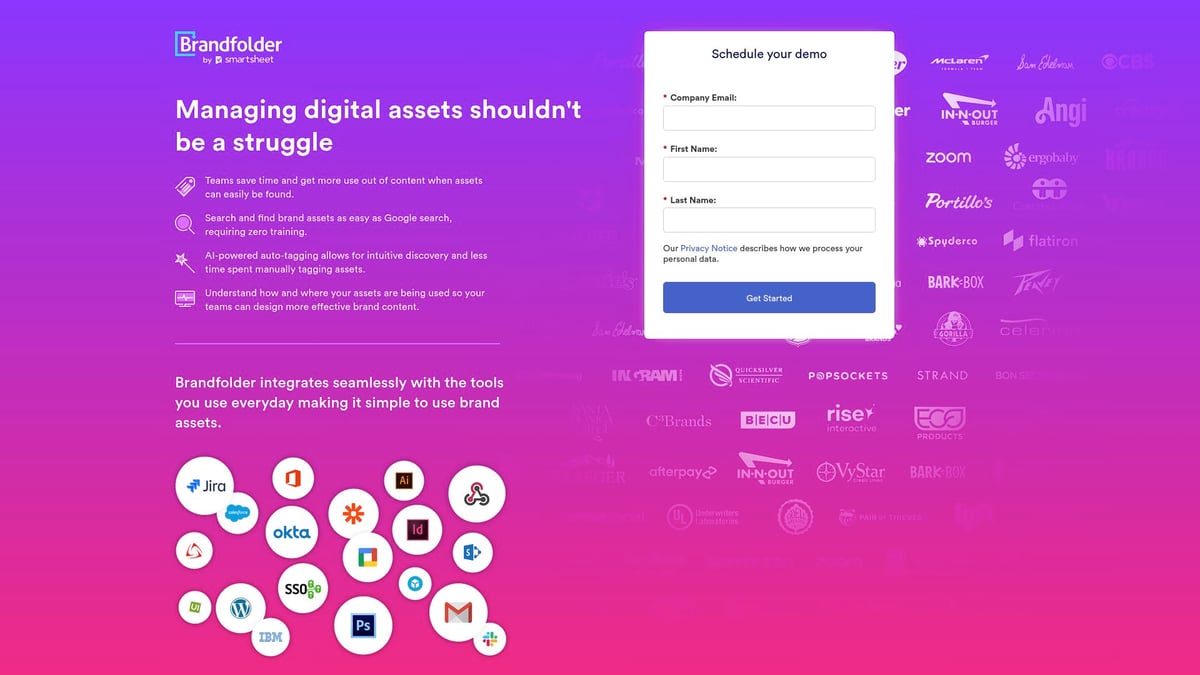
Pricing: Custom quotes and demo available.
Features:
- Smart asset organization with AI-powered insights
- Workflow automation for approvals and publishing
- Easy asset sharing with external partners
Unique Selling Points:
- High adoption rates due to intuitive interface
- Actionable analytics for asset performance
Best For: Marketing and creative teams, agencies, CPG brands needing efficient asset management.
Pros:
- Robust analytics dashboards
- User-friendly onboarding
Cons:
- Custom pricing can be opaque
- Advanced features may require training
Example: Under Armour leverages Brandfolder to support its global marketing initiatives, showing how a digital asset manager can scale with brand growth.
Brandfolder is perfect for teams that want a digital asset manager to streamline collaboration and boost marketing impact.
Adobe Experience Manager Assets
Adobe Experience Manager Assets is a digital asset manager built for creative professionals who rely on the Adobe ecosystem. Its cloud-native platform offers dynamic media delivery and advanced automation.
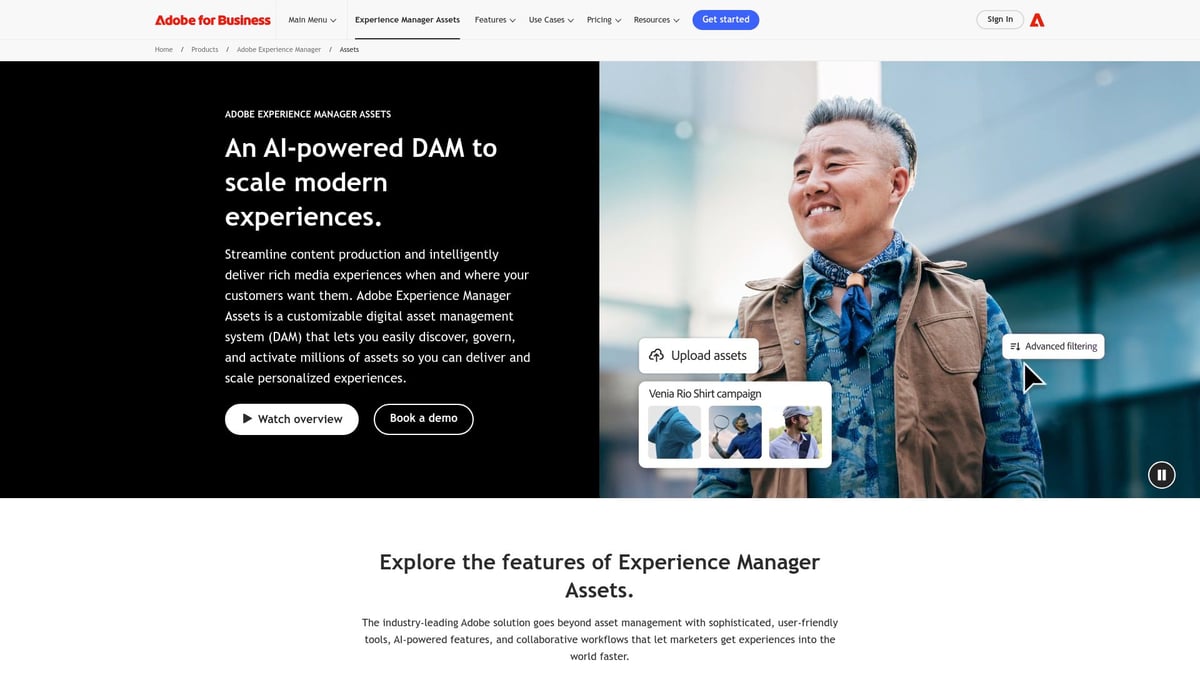
Pricing: Custom enterprise pricing.
Core Features:
- Cloud-native DAM platform
- Dynamic media delivery for omnichannel use
- AI-driven tagging and asset discovery
- Seamless integration with Adobe Creative Cloud
Key Benefits:
- End-to-end content lifecycle management
- Scalable infrastructure for enterprises
Target Audience: Enterprises, creative professionals, publishers.
Pros:
- Deep Adobe ecosystem integration
- Powerful automation tools
Cons:
- Steep learning curve
- High cost of entry
Example: Major publishers trust Adobe Experience Manager Assets for omnichannel content delivery and efficient asset workflows.
For organizations already invested in Adobe, this digital asset manager offers unmatched integration and creative flexibility.
Stockpress
Stockpress is an accessible digital asset manager designed for small to mid-sized businesses and nonprofits. Its focus on eliminating duplicate files and providing unlimited users makes it a practical choice for growing teams.
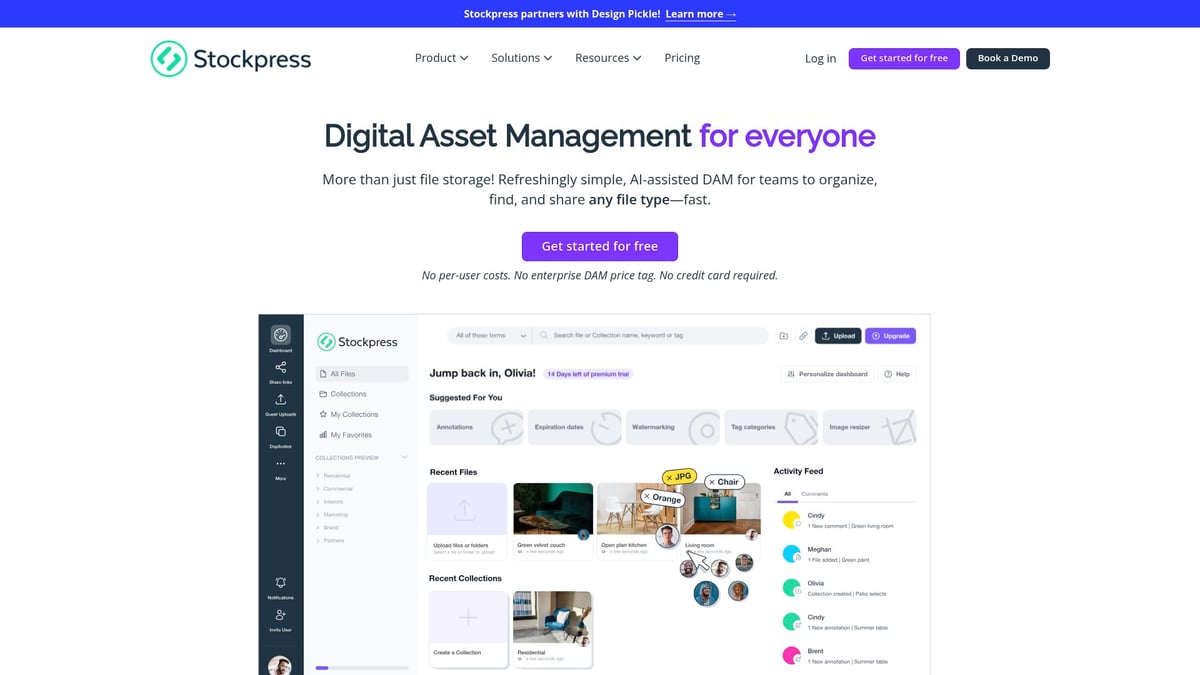
Pricing: Starts at $39/month (billed annually), with a free plan available.
Features:
- No-duplication asset organization
- Flexible permissions for secure sharing
- Unlimited users
- Advanced search and tagging
Unique Selling Points:
- Affordable for SMBs and nonprofits
- Easy onboarding process
Ideal For: Small to mid-sized businesses, agencies, and nonprofits needing a straightforward digital asset manager.
Pros:
- Simple, clean interface
- Cost-effective, especially for teams
Cons:
- Lacks some advanced features found in enterprise DAMs
Example: Nonprofits use Stockpress to organize and share their media libraries, demonstrating how a digital asset manager can simplify collaboration for resource-limited teams.
If you want a digital asset manager that’s affordable and easy to use, Stockpress is a smart pick.
Acquia DAM (Widen)
Acquia DAM (formerly Widen) is a highly configurable digital asset manager that excels in metadata management and workflow automation. Its deep integration capabilities make it a favorite among enterprises with complex needs.
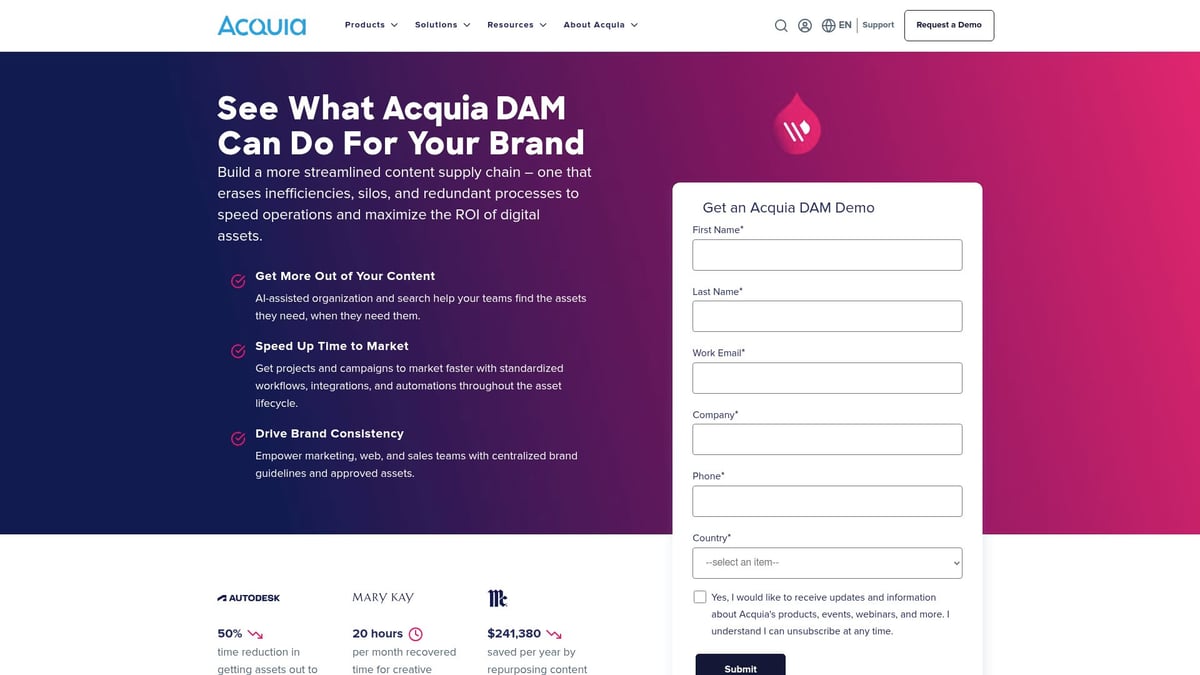
Pricing: Custom, with a free demo.
Features:
- Advanced metadata and rights management
- Workflow automation for approvals and versioning
- Integration with CMS and PIM systems
Key Benefits:
- Customizable for intricate requirements
- Strong metadata and digital rights control
Target Audience: Enterprises, manufacturers, higher education.
Pros:
- Deep configurability to match unique workflows
- Excellent customer support
Cons:
- Complex implementation
- Requires user training for full adoption
Example: Universities leverage Acquia DAM for digital archives and marketing, showing how a digital asset manager can adapt to highly specialized environments.
For organizations with demanding digital asset manager requirements, Acquia DAM stands out for flexibility and support.
Air
Air is a modern digital asset manager created for creative and marketing teams who value speed and collaboration. Its visual boards and AI-driven tagging make asset management intuitive and fast.
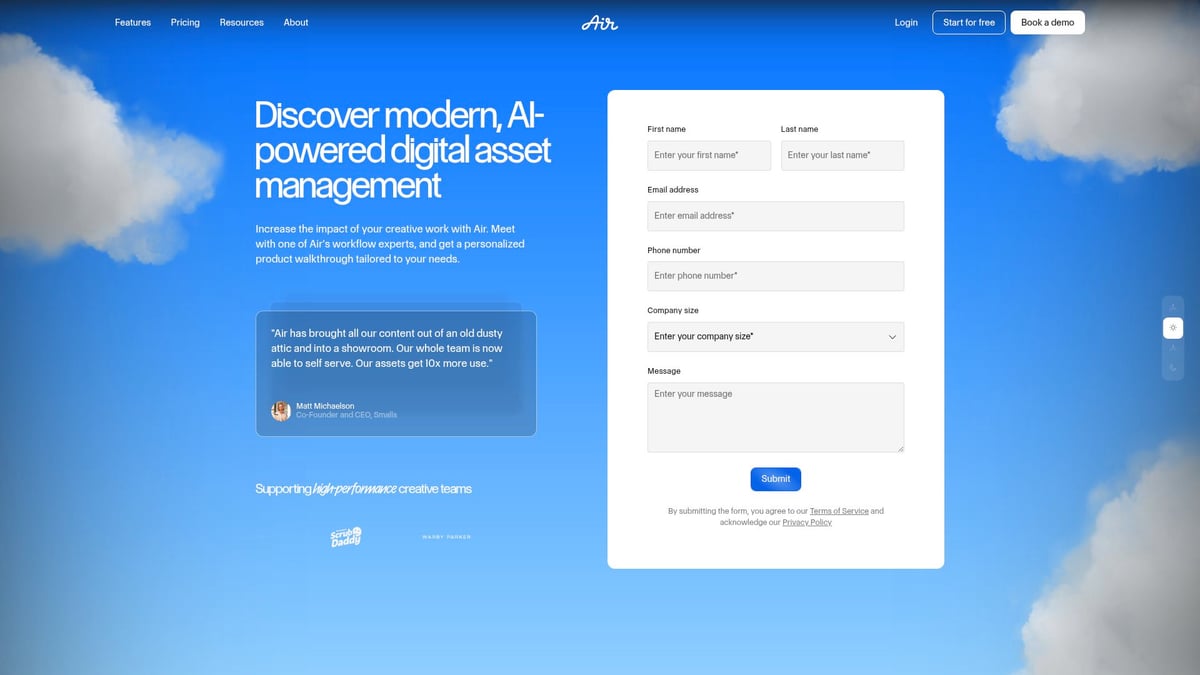
Pricing: Starts at $250/month (billed annually), with a free plan available.
Features:
- Agile, collaborative workspace
- AI-powered tagging and search
- Real-time feedback and comments
- Visual asset boards for campaign planning
Unique Selling Points:
- Designed for rapid, visual collaboration
- Flexible plans for agencies and startups
Ideal For: Agencies, distributed creative teams, startups seeking an agile digital asset manager.
Pros:
- Fast setup and onboarding
- Highly visual, intuitive interface
Cons:
- Fewer advanced enterprise features
Example: Startups use Air to manage campaign assets, highlighting how a digital asset manager can help fast-moving teams stay organized.
If your team needs a digital asset manager that’s as agile as your workflow, Air is an excellent choice.
Quick Comparison Table
| Tool | Pricing | Best For | Standout Feature |
|---|---|---|---|
| Bynder | Custom | Enterprises, brands | Brand portals, integrations |
| MediaValet | Custom | Agencies, media | Unlimited users/storage |
| Brandfolder | Custom | Marketing, CPG | Actionable analytics |
| Adobe AEM | Custom | Publishers, creatives | Adobe integration, automation |
| Stockpress | From $39/month | SMBs, nonprofits | No-duplication, affordability |
| Acquia DAM | Custom | Enterprises, education | Metadata management |
| Air | From $250/month | Agencies, startups | Visual boards, fast collaboration |
Each digital asset manager on this list brings something unique to the table. Whether you need enterprise scalability or budget-friendly simplicity, there’s a solution tailored for your needs.
Key Features to Look for in a Digital Asset Manager Tool
Choosing the right digital asset manager can feel overwhelming. With so many tools on the market, it is crucial to focus on the features that truly make a difference in 2025. What sets the best solutions apart? Let’s break down the must-haves and how to match them to your business needs.
Core Capabilities for 2025
A modern digital asset manager is more than just a storage space. In 2025, these platforms must deliver speed, intelligence, and security. Here are the essential features every business should demand:
- AI-powered search and automated tagging: Instantly find images, videos, or documents with smart recommendations and metadata enrichment.
- Permission controls and user roles: Protect sensitive files and manage who can view, edit, or share assets.
- Workflow automation: Streamline approvals, track versions, and automate publishing to save time.
- Integrations: Connect seamlessly with creative tools, CMS, and marketing platforms to keep your content moving.
- Analytics: Monitor asset usage, engagement, and ROI for data-driven decisions.
- Mobile and cloud accessibility: Enable remote work and collaboration from anywhere.
- Scalability: Handle growing libraries without sacrificing performance.
A helpful way to compare features is with a quick table:
| Feature | Why It Matters in 2025 |
|---|---|
| AI Search/Tagging | Rapid retrieval, smarter organization |
| Permissions | Secure collaboration, compliance |
| Workflow Automation | Faster approvals, fewer bottlenecks |
| Integrations | Unified content ecosystem |
| Analytics | Measure impact, optimize strategy |
| Cloud/Mobile Access | Flexibility for hybrid teams |
| Scalability | Future-proof growth |
Cloud-based solutions are especially valuable for scalability and remote access. For a deeper look at why cloud-native DAMs are leading the way, check out this overview of cloud-based DAM solutions.
Evaluating the Right Fit
Not every digital asset manager suits every business. Start by assessing your team size, the volume and types of assets you manage, and your technical expertise. Are you a small team needing simplicity, or an enterprise with complex workflows?
Onboarding and training are crucial. Choose a platform with clear documentation, responsive support, and training resources. This ensures your team can quickly adapt and maximize the tool’s benefits.
Cost is another factor. Don’t just look at the price tag—consider the feature set, scalability, and potential ROI. Sometimes, investing in a robust digital asset manager saves money by reducing time spent searching for files and preventing costly errors.
Match the tool to your needs. For example, a creative agency might prioritize real-time collaboration, while a large enterprise may need advanced security and compliance controls. Data-driven insights, such as adoption rates and satisfaction scores, can help guide your decision.
In 2025, the right digital asset manager empowers your team, streamlines workflows, and positions your business for future growth.
How to Successfully Implement a Digital Asset Manager Tool in Your Organization
Adopting a digital asset manager can be transformative, but successful implementation is key to unlocking its full value. Let’s break down the process into clear steps so your team can avoid common pitfalls and see results faster.
Planning and Preparation
Start by auditing your current digital asset library. Identify what files you have, where they’re stored, and who needs access. This inventory will reveal gaps, duplicates, and any outdated assets that need to be retired.
Next, set clear goals for your digital asset manager implementation. Are you aiming for faster asset retrieval, better brand consistency, or improved compliance? Goals help align your team and measure progress.
Engage stakeholders early. Include IT, marketing, creative, and any team that will interact with the digital asset manager. Their input will shape requirements and foster buy-in.
Prepare your metadata schema and taxonomy. Consistent naming conventions, tags, and categories make assets easy to find. For guidance on digital workflows and asset organization, consider reviewing the digital product management guide.
Map your current workflows to see where a digital asset manager can bring automation or streamline approvals. Documenting these processes helps during setup and training.
Rollout and Adoption
Roll out your digital asset manager in phases. Start with a pilot group to test workflows and gather feedback. Use this feedback to refine your setup before expanding to the entire organization.
Offer hands-on training sessions and create easy-to-follow documentation. Encourage users to ask questions and share their experiences. Change management strategies, like celebrating small wins and highlighting time saved, boost adoption.
Track key performance indicators, such as search time reduction, asset reuse rates, and user engagement. These metrics show the impact of your digital asset manager and help justify the investment.
Address common challenges proactively. Resistance to change, integration issues, and data migration can slow progress. For tips on connecting your digital asset manager with other platforms, check out seamless DAM integrations.
Real-world examples show that organizations who plan carefully, involve stakeholders, and support their teams see the smoothest transitions. With the right approach, your digital asset manager will quickly become a core part of your digital strategy.
Future Trends in Digital Asset Management for 2025 and Beyond
The future of digital asset manager solutions is unfolding rapidly, with innovation shaping how organizations control their ever-expanding digital libraries. As businesses look ahead to 2025, several key trends are redefining what a modern digital asset manager can do.
AI and Predictive Automation
AI and machine learning are revolutionizing the digital asset manager landscape. Expect even smarter asset tagging, search, and automated metadata enrichment. Predictive algorithms will suggest assets based on campaign needs, past usage, and user preferences, saving time and boosting creative output.
Emerging Technology Integrations
The rise of AR, VR, and generative AI is pushing digital asset manager platforms to support new asset types and workflows. For example, advanced DAMs are now accommodating 3D files and immersive content, a trend highlighted in 3D asset support in DAM. Seamless integration with these technologies is becoming essential for brands delivering next-level experiences.
Enhanced Security and Compliance
With data privacy regulations tightening, digital asset manager tools are prioritizing robust security, digital rights management, and compliance features. Automated policy enforcement, audit trails, and granular permissions will be standard, reducing the risk of breaches and ensuring regulatory alignment.
Decentralized and Blockchain-Based Solutions
Blockchain is emerging as a game-changer for digital asset manager systems, enabling transparent ownership records, immutable audit logs, and decentralized access control. This technology is particularly valuable for industries handling sensitive or high-value digital assets.
Adaptation for Remote and Hybrid Teams
Remote work is here to stay, so digital asset manager platforms are evolving with cloud-based access, mobile functionality, and collaborative features. The demand for intuitive tools is rising among creators and distributed teams, as explored in digital tools for creators.
Market Growth and User Expectations
The digital asset manager market is projected to see robust growth, fueled by content volume surges and higher adoption rates across sectors. Users now expect intuitive interfaces, rapid onboarding, and analytics that prove ROI, setting a new bar for DAM innovation.
As these trends converge, investing in a future-ready digital asset manager is the key to staying agile, secure, and competitive in 2025 and beyond.
If you’re feeling inspired to take control of your digital assets and set up systems that work for you, why not take the next step toward building your own digital product business? Whether you’re a solo creator or leading a team, mastering digital asset management is just one part of creating a brand that grows and sells on autopilot. At CreateSell, you’ll find practical guidance and expert insights to help you move from trading your time to selling digital products. Ready to put what you’ve learned into action? Get Started and start shaping your digital future today.